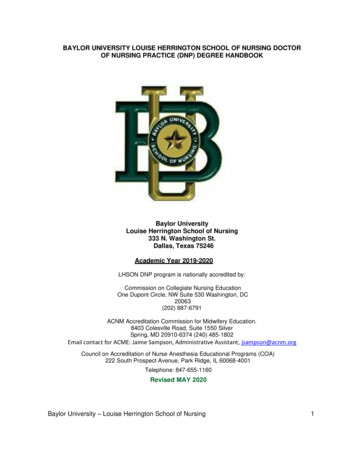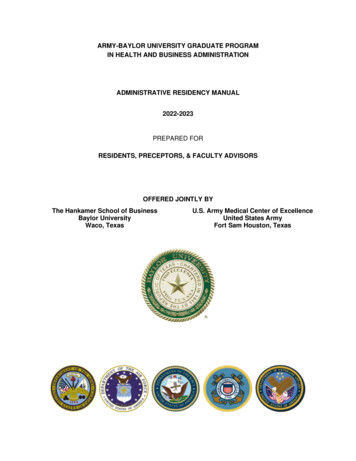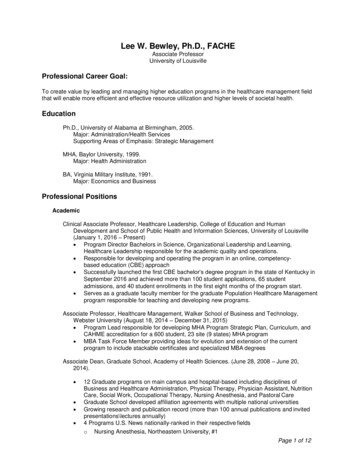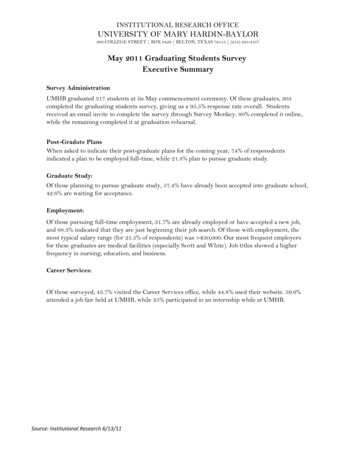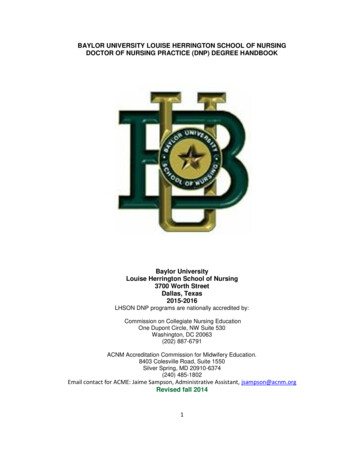
Transcription
BAYLOR UNIVERSITY LOUISE HERRINGTON SCHOOL OF NURSINGDOCTOR OF NURSING PRACTICE (DNP) DEGREE HANDBOOKBaylor UniversityLouise Herrington School of Nursing3700 Worth StreetDallas, Texas2015-2016LHSON DNP programs are nationally accredited by:Commission on Collegiate Nursing EducationOne Dupont Circle, NW Suite 530Washington, DC 20063(202) 887-6791ACNM Accreditation Commission for Midwifery Education.8403 Colesville Road, Suite 1550Silver Spring, MD 20910-6374(240) 485-1802Email contact for ACME: Jaime Sampson, Administrative Assistant, jsampson@acnm.orgRevised fall 20141
Table of ContentsIntroduction. 3Program Goal. 3DNP Graduate Outcomes . 3General Policies . 7Course of Study . 7THE CAPSTONE PROJECT . 7Student Responsibilities for Capstone Project. 8Committee Membership . 9Role and Responsibilities of the Capstone Committee. 9Final Oral Presentation Defense of the Capstone Project . 11THE DNP PORTFOLIO . 13Appendix A – Degree Plans and Course Descriptions . 14Appendix B – Prospective Capstone Committee Form . 26Appendix C – Capstone Project Committee Form . 27Appendix D – Capstone Project Proposal Approval Form . 28Appendix E – Final Project Approval Form . 292
IntroductionThe Louise Herrington School of Nursing (LHSON) Doctor of Nursing Practice (DNP) degreeDNP is a clinical doctoral program designed in response to professional mandates to moveadvanced nursing practice education to the doctoral level and to meet the societal need forimproved healthcare through the education of nurse practitioners (NPs) and midwives.The DNP program is congruent with the overall strategic plan for Baylor University asdescribed in Pro Futuris, as well as the specific strategic and operational plans for theLHSON. The program is of particular value to the LHSON because it prepares providers tocare for vulnerable populations such as women and families in the United States andglobally, reflects an approach to life as servant leader and professional nursing as a calling.A nurse practitioner or midwife prepared at the DNP level can promote and improve thequality of healthcare for individuals, populations and communities in the United States andacross the globe.Program GoalThe DNP graduates will acquire the knowledge and ability to translate research into practice.DNP graduates will be prepared as future leaders and mentors by establishing scholarlyexcellence for the profession, advocating for improved healthcare outcomes, and translatingthe evidence into personal practice. Graduates will also disseminate research and aid in theintegration of new discoveries in the healthcare arena.DNP Graduate OutcomesCompetencies expected of a DNP graduate from the LHSON are congruent with the eightEssentials for Doctoral Education for Advanced Practice published by the AmericanAssociation of Colleges of Nursing and outlined below. The curriculum is designed to enablethe graduate to attain these outcomes. These competencies are:Essential I: Scientific Underpinnings for PracticeThe DNP program prepares the graduate to:1.2.3.Integrate nursing science with knowledge from ethics, the biophysical, psychosocial, analytical, and organizational sciences as the basis for the highest levelof nursing practice.Use science-based theories and concepts to:a. determine the nature and significance of health and healthcare deliveryphenomena;b. describe the actions and advanced strategies to enhance, alleviate,and ameliorate health and healthcare delivery phenomena, andc. evaluate outcomes.Develop and evaluate new practice approaches based on nursing theoriesand theories from other disciplines.3
Essential II: Organizational and Systems Leadership for Quality Improvement andSystems ThinkingThe DNP program prepares the graduate to:1.2.3.Develop and evaluate care delivery approaches that meet current and futureneeds of patient populations based on scientific findings in nursing and otherclinical sciences, as well as organizational, political, and economic sciences.Ensure accountability for quality of healthcare and patient safety forpopulations with whom they work.a. Use advanced communication skills/processes to lead qualityimprovement and patient safety initiatives in healthcare systems.b. Employ principles of business, finance, economics, and health policy todevelop and implement effective plans for practice-level and/or systemwide practice initiatives that will improve the quality of care delivery.c. Develop and/or monitor budgets for practice initiatives.d. Analyze the cost-effectiveness of practice initiatives accounting for riskand improvement of healthcare outcomes.e. Demonstrate sensitivity to diverse organizational cultures and populationsincluding patients and providers.Develop and/or evaluate effective strategies for managing the ethicaldilemmas inherent in patient care, the healthcare organization and research.Essential III: Clinical Scholarship and Analytical Methods for Evidence-Based PracticeThe DNP program prepares the graduate to:1.2.3.4.5.6.7.Use analytic methods to critically appraise existing literature and otherevidence to determine and implement the best evidence for practice.Design and implement processes to evaluate outcomes of practice, practicepatterns and systems of care within a practice setting, healthcare organization,or community against national benchmarks to determine variances in practiceoutcomes and population trends.Design, direct, and evaluate quality improvement methodologies to promotesafe, timely, effective, efficient, equitable, and patient-centered care.Apply relevant findings to develop practice guidelines and improve practiceand the practice environment.Use information technology and research methods appropriately to:a. Collect appropriate and accurate data to generate evidence for nursingpractice;b. Inform and guide the design of databases that generate meaningfulevidence for nursing practicec. Analyze data from practiced. Design evidence-based interventionse. Predict and analyze outcomesf. Examine patterns of behavior and outcomesg. Identify gaps in evidence for practiceFunction as a practice specialist/consultant in collaborative knowledgegenerating research.Disseminate findings from evidence-based practice and research to improvehealthcare outcomes4
Essential IV: Information Systems/Technology and Patient Care Technology for theImprovement and Transformation of Health CareThe DNP program prepares the graduate to:1.2.3.4.5.Design, select, use, and evaluate programs that evaluate and monitoroutcomes of care, care systems, and quality improvement including consumeruse of healthcare information systems.Analyze and communicate critical elements necessary to the selection, useand evaluation of healthcare information systems and patient care technology.Demonstrate the conceptual ability and technical skills to develop and executean evaluation plan involving data extraction from practice information systemsand databases.Provide leadership in the evaluation and resolution of ethical and legal issueswithin healthcare systems relating to the use of information, informationtechnology, communication networks, and patient care technology.Evaluate consumer health information sources for accuracy, timeliness, andappropriateness.Essential V: Health Care Policy for Advocacy in Health CareThe DNP program prepares the graduate to:1.2.3.4.5.6.7.Critically analyze health policy proposals, health policies, and related issuesfrom the perspective of consumers, nursing, other health professions, andother stakeholders in policy and public forums.Demonstrate leadership in the development and implementation ofinstitutional, local, state, federal, and/or international health policy.Influence policy makers through active participation on committees, boards, ortask forces at the institutional, local, state, regional, national, and/orinternational levels to improve healthcare delivery and outcomes.Educate others, including policy makers at all levels, regarding nursing, healthpolicy, and patient care outcomes.Advocate for the nursing profession within the policy and healthcarecommunities.Develop, evaluate, and provide leadership for healthcare policy that shapeshealthcare financing, regulation, and delivery.Advocate for social justice, equity, and ethical policies within all healthcarearenas.5
Essential VI: Interprofessional Collaboration for Improving Patient and PopulationHealth OutcomesThe DNP program prepares the graduate to:1.2.3.Employ effective communication and collaborative skills in the developmentand implementation of practice models, peer review, practice guidelines,health policy, standards of care, and/or other scholarly products.Lead interprofessional teams in the analysis of complex practice andorganizational issues.Employ consultative and leadership skills with intraprofessional andinterprofessional teams to create change in healthcare and complexhealthcare delivery systems.Essential VII: Clinical Prevention and Population Health for Improving the Nation’sHealthThe DNP program prepares the graduate to:1.2.3.Analyze epidemiological, biostatistical, environmental, and other appropriatescientific data related to individual, aggregate, and population health.Synthesize concepts, including psychosocial dimensions and cultural diversity,related to clinical prevention and population health in developing,implementing, and evaluating interventions to address healthpromotion/disease prevention efforts, improve health status/access patterns,and/or address gaps in care of individuals, aggregates, or populations.Evaluate care delivery models and/or strategies using concepts related tocommunity, environmental and occupational health, and cultural andsocioeconomic dimensions of health.Essential VIII: Advanced Nursing PracticeThe DNP program prepares the graduate to:1.2.3.4.5.6.7.Conduct a comprehensive and systematic assessment of health and illnessparameters in complex situations, incorporating diverse and culturallysensitive approaches.Design, implement, and evaluate therapeutic interventions based on nursingscience and other sciences.Develop and sustain therapeutic relationships and partnerships with patients(individual, family or group) and other professionals to facilitate optimal careand patient outcomes.Demonstrate advanced levels of clinical judgment, systems thinking, andaccountability in designing, delivering, and evaluating evidence-based care toimprove patient outcomes.Guide, mentor, and support other nurses to achieve excellence in nursingpractice.Educate and guide individuals and groups through complex health andsituational transitions.Use conceptual and analytical skills in evaluating the links among practice,organizational, population, fiscal, and policy issues.”6
General PoliciesAs an academic unit of Baylor University, the LHSON abides by the policies found in theGraduate Catalog in regard to such items as tuition, honor code, maximum length of time inprogram and other general information. LHSON also has policies specific to the school thatcan be found in the LHSON Graduate Student Information Guide.The DNP curriculum consists of 75 post baccalaureate credits in nursing. Of that total, nomore than 37 may be transferred credits. The majority of the credits will be transferred forindividuals who already possess a master’s degree in nursing or who already are certified asa nurse-midwife or nurse practitioner. An individualized plan of study can be designed forthese students in order to assure that they obtain the necessary curricular content. Of the 75credits, 7 credits are specific for a DNP Capstone project.Course of StudyStudents who meet the admission requirements of the Graduate School of Baylor Universityand the requirements of the Louise Herrington School of Nursing may be admitted into theDNP program either as full-time or part-time students. Full-time students are anticipated tocomplete the program within nine semesters from the BSN entry. Post masters’ studentsmust complete a minimum of 38 credits at Baylor University for completion of the 75 creditDNP in an anticipated 5 semesters. Students enter the program in the fall for a moreseamless movement through the planned curriculum. DNP students must have completed agraduate level statistics course prior to matriculation into the program.In some instances, a pretest may be required to demonstrate that an individual alreadypossesses the information taught in a course. Additionally, a clinical practice assessmentmay be required to validate current clinical competency before transfer of clinicalmanagement courses and/or clinical practicum credits.Appendix A contains the standard BSN to DNP curriculum for midwifery and nursepractitioner students. Appendix B contains the standard Post Masters DNP curriculum.Appendix C contains course descriptions.THE CAPSTONE PROJECTTraditionally, doctoral education culminates in the completion of a scholarly project. TheCapstone project is an experience that synthesizes knowledge and develops a skill set thatserves as a foundation for future scholarly practice. The Capstone project is relevant toadvanced practice nursing; characterized by a systematic process; targeted to a populationof interest; addresses the contextual aspect of the setting; includes measurable outcomes;and includes a dissemination component. Unlike the PhD dissertation that aims to producenew knowledge, the theme uniting all Capstone projects is its direct relevance to clinicalpractice.There is a fair amount of ambiguity in the classification of Capstone projects and thecategories provided below may overlap. The important point is that the major aim of theCapstone project is translation of evidence to practice and not the generation of newknowledge.7
Broad categories of Capstone projects include: Evaluation of practice, practice environments and systems of careTranslation of research evidence into practice (i.e. program implementation andevaluation) Decreasing variations in healthcare practices (i.e. quality improvement projects;establishing clinical pathways; and development, implementation and evaluation ofclinical practice guidelines in a clinical setting) Improving population outcomes Policy development, implementation, evaluation Evidence based practice changesThe student is encouraged to go to the Doctors of Nursing Practice web site to view abstractsof DNP projects.Capstone CoursesThere are 4 Capstone courses. In Capstone I (NUR61C1) the student develops the Capstonetopic and the framework for the project. The second course, Capstone II (NUR62C2), isproposal writing and defense. In Capstone III (NUR62C3) the student implements andevaluates the project. During the final course, Capstone IV (NUR62C4), the student writesthe final paper/report and presents the project results to the agency or other professionalaudience and presents an oral defense.Student Responsibilities for Capstone Project1.By the fifth semester of study, or an equivalent period for students with part-timestudy, the DNP student must begin the Capstone process by enrolling in Capstone I.The student must have completed Scientific Inquiry II prior to enrollment in Capstone I2.The student will use the form in Appendix D to submit three possibilities for CapstoneProject Chair along with the title of the project and a purpose statement to theGraduate Program Director for approval. The Capstone Project Chair must be amember of the Baylor University Graduate Faculty. A list of current eligible facultymembers will be obtained during the first class of Capstone I.3.During Capstone I, once the Capstone Project Chair is approved, the student will, withinput from the chair, form a Capstone project committee comprised of the CapstoneProject Chair and a minimum of two other members. Once all members have agreedto serve, the student should obtain the signatures of all committee members on the“Capstone Project Committee Form” (Appendix E) and submit the form to theGraduate Program Director.4.The student will enroll in Capstone II under the Capstone Project Chair’s section.During this course the student will develop a Capstone project proposal with theguidance of the Capstone Project Chair and input from the committee. The studentwill defend the project with the committee’s approval. After successfully defending theproposal, the student will submit the project to the Baylor University IRB committee.5.Before IRB submission the student must upload a certificate demonstratingcompletion of the Collaborative Institutional Training Initiative (CITI).6.Once CITI training is completed and the project is successfully defended, it will besubmitted to IRB Net which can be found under the research button on the UniversityResearch home page.7.The project will be reviewed by the IRB committee after the Capstone Project Chairhas approved it on IRB Net.8
After Baylor University IRB approval, the proposal may need to be submitted to an agencyIRB for approval. It is the student’s responsibility to find out if this is needed prior toimplementation of the project.8.After IRB approval has been received, the student will implement and evaluate theproject under the supervision of the Capstone Project Chair in the Capstone III course(enroll in the Capstone Project Chair’s section).9.Once the project has been completed and evaluated, the student and CapstoneProject Chair will determine the format of the final product. The student will enroll inCapstone IV (under the Capstone Project Chair’s section) at this time.10.Before graduating, the student must show a dissemination process for the work anddefend the result.11.Close out the IRB with a short report form on IRB net.12.Submit final copy of the Capstone final report/manuscript to the Graduate Programoffice.13.Enroll and submit the final Capstone abstract to the Virginia Henderson Librarydepository for Baylor DNP projects. Helpful GuidesCommittee MembershipOnce the committee is officially formed, the candidate cannot initiate changes in themembership without approval of the Capstone Project Chair. However, if a faculty memberresigns from the committee, the student (in consultation with the chair) will invite anothermember to join and notify the Director of the Graduate Program in writing of this change.Should the Capstone Project Chair resign, the student (in consultation with the rest of thecommittee and the Director of Graduate Program) will invite another faculty member to serveas the chair. The student may request a change in Capstone Project Chair after consultationwith the Graduate Program Director if there are extenuating circumstances. A minimum oftwo individuals will serve as committee members, at least one of whom is a LHSON facultymember; other members may be agency representatives or an individual with specialexpertise related to the project.Role and Responsibilities of the Capstone CommitteeMembers of the committee and the chair must meet the following criteria:Capstone Project Chair Qualifications1.2.3.4.Hold graduate faculty status at LHSONHold earned DoctorateBe regularly available to studentHave current CITI training through Baylor University IRB siteCommittee Members Qualifications1.2.Hold Master degree (doctoral degree preferred)If possible, possess complementary areas of expertise to guide content and methodsof project9
Capstone Project Chair Responsibilities1.2.3.4.5.Provide guidance during the development of the Capstone project proposal and IRBsubmission.Provide assurance of IRB compliance.Provide supervision of project implementation, evaluation and dissemination offindings.Assure that the entire committee meets with the student at least once during thedevelopment of the proposal and once at the time the completed proposal ispresented to the committee.Provide date, time, and Capstone project title to the Graduate Program Office toschedule final defense.Committee Members Responsibilities1.2.3.4.5.6.Attend all committee meetings.Participate as requested by the student and Capstone Project Chair in proposaldevelopment.Appraise proposal in a timely manner and provide feedback/critique to student andCapstone Project Chair.Participate in the project implementation and evaluations as requested by the studentand Capstone Project Chair.Appraise final written report and provide feedback/critique to student and CapstoneProject ChairCommittee members must sign the Capstone Project Proposal Approval Form(Appendix F) and the Final Project Approval Form (Appendix G).Capstone Project ProposalA Capstone project rarely presents itself to a student. Such an endeavor usually evolves aftermuch study and effort by the student. To facilitate the process and aid the student, aCapstone project proposal is developed by the student under the supervision of theCapstone Project Chair and with participation of the members of the committee.The proposal should include a statement of the problem, a needs assessment, fishboneexemplar or rationale for the project. Relevant literature is reviewed to form the basis for theproject. The proposal should include a purpose statement, objectives, activities, timetable,anticipated resources and an evaluation plan including data analysis method. This documentis characterized by logical progression of thought, appropriate literary style, and scholarlywriting.The proposal should be double-spaced in 12-point Times New Roman font with 1-inchmargins and should be congruent with the standards of the most recent edition of thePublication Manual of the American Psychological Association (APA). The proposal shouldnot exceed 25 pages exclusive of references and appendices.10
Once the Capstone Project Chair deems the proposal complete, the proposal is defended bythe student at a meeting with the chair and members of the committee. The student shouldprovide a copy of the proposal to each committee member at least 2 weeks prior to theproposal meeting. The student should be prepared to discuss the entire proposal at theproposal meeting. The student should bring two copies of the “Capstone Project ProposalApproval Form” (Appendix G) to the proposal defense.At the completion of the proposal defense, the Capstone Project Chair and the committee willformulate their recommendations. These recommendations include:1.2.3.Accept the proposal as written/or with minor revisions requested.Require major revisions that mandate a re-review by the committee.Reject the proposal (i.e. due to major safety issues, major flaws, unfeasibletimetable).The chair notifies the Director of Graduate Programs of the outcome of the proposal defense.If minor revisions are required, the candidate should submit a revised proposal to theCapstone Project Chair within one month. If major revisions are required or the proposal isrejected, the Capstone Project Chair (and possibly members of the committee) will work withthe candidate to make requested changes. During this time the student will be required to reenroll in Capstone II and another proposal meeting will be held, with the above stepsfollowed. If acceptable progress is not demonstrated after enrollment in Capstone II on twooccasions, the candidate may be dismissed from the program.Consultations with the Capstone Committee ChairInformal communication between the student and the Capstone Project Chair should beregular and encouraged. However, a student must consult with the chair before:1.2.3.4.Submitting any research grants to fund part or the entire Capstone project.Submitting any abstracts for conferences or publications that will report findings.Submitting to the public domain any materials that are integral components to theproject.Copyrighting the Capstone project or components thereof.Final Oral Presentation Defense of the Capstone ProjectThe DNP program includes both a written summary report and oral presentation of theCapstone project. The student must provide a final written report to the entire committee atleast two (2) weeks prior to the final oral presentation defense. The Capstone ProjectChair must approve the final written report prior it being sent to the committee. The finalpresentation defense is open to the public.The purpose of the final oral presentation defense is for the student to demonstrate that he orshe successfully met the requirements of the Capstone project. This decision will be made bythe Capstone Project Chair and committee members alone. A unanimous vote by thecommittee to approve the Capstone project written report is required.11
In addition to voting to accept the written report or manuscript, the recommendations of thecommittee may include revisions to the report or manuscript, or further work on the project. Inthe event that the committee requests revisions to the final written report or manuscript, orfurther work on the project, the deadline is one week after defense. If revisions to the finalwritten report or manuscript or further work on the project are required, the committee willspecify at the time of the final oral presentation defense if a re-review of the revised writtenreport/manuscript by the committee is required. In the event that the committee requests are-review, the student should re-enroll in Capstone IV while carrying out therecommendations of the committee. If the requested revisions to the final written reportare minor and can reasonably be accomplished in time for graduation the student is notrequired to re-enroll. In order to graduate, the student must complete the final oralpresentation defense by the last official day of class in any semester. Finished edits tothe paper/report need to be completed and submitted to the Graduate Program Office by thegraduation date.If a re-review of the final written report or manuscript is necessary, the student will be givenan additional opportunity to complete the final oral presentation defense. If, at the secondoral presentation, the student is unable to satisfy the committee that he or she successfullymet the requirements for the Capstone project, the student will be dismissed from theprogram.Once the committee votes to approve the Capstone project written report or manuscript, the“Final Project Approval Form” (Appendix E) must be signed by all members of the committee.The candidate is responsible for submitting this form to the Director of the Graduate Program.Archiving of Capstone Project Final Report/ManuscriptCapstone project final reports/papers will be archived in an electronic file on the Faculty/StaffCommunity Blackboard site. Capstone Project Chairs are responsible for providing anelectronic copy of the final report/manuscript to the Graduate Program Office for posting inPDF file format to the Faculty/Staff Community Blackboard site. A master list on both theFaculty/Staff Community Blackboard site and the Advance Practice Nurse CommunityBlackboard site will include student name, Capstone Project Title, Capstone Project Chairand committee members and date of graduation. In addition, the student will be asked tosubmit an abstract of his/her work to the Virginia Henderson library for retention under theBaylor University repository.Dissemination of the Capstone ProjectAs part of the Capstone project requirement, the student must disseminate the results of theproject. There are several avenues for project dissemination, including submission of amanuscript to a professional peer review publication. Other avenues for disseminationinclude submission of an abstract for a presentation or poster at a local, regional, national orinternational professional meeting, or submission of a brief report to a professionalpublication. Manuscript and abstract submissions must be completed and verified by the daythat final grades are due. Each student is required to provide a formal presentation to the keystakeholders of the agency/organization where the capstone was performed. The date andevidence of the presentation must be submitted in the portfolio.12
THE DNP PORTFOLIOThe DNP portfolio represents a body of work that the student produces during matriculationof the DNP degree. All papers and other graded assignments as well as skills checksheets and final evaluations by preceptors need to be included in the portfolio. Thisportfolio must be completed prior to graduation. It will be reviewed by the ProgramCoordinator of the specialty track for BSN to DNP students and by the Graduate ProgramDirector for
credits, 7 credits are specific for a DNP Capstone project. Course of Study Students who meet the admission requirements of the Graduate School of Baylor University and the requirements of the Louise Herrington School of Nursing may be admitted into the DNP program either as full-time or part-time students. Full-time students are anticipated to


